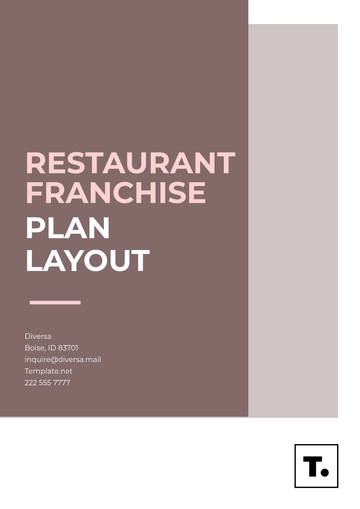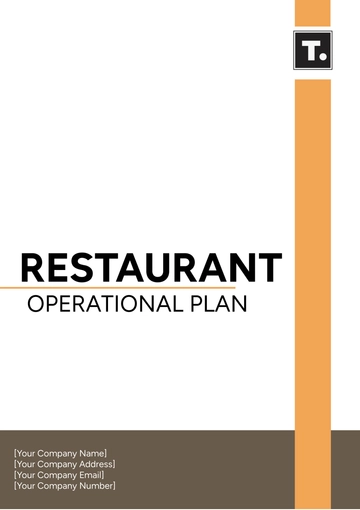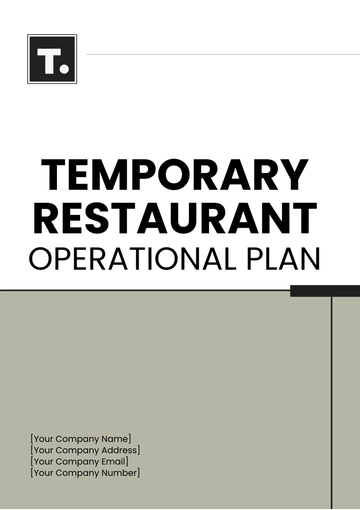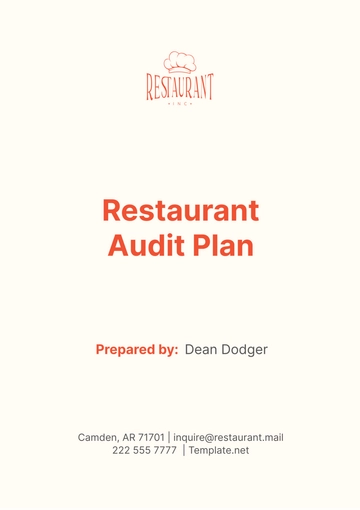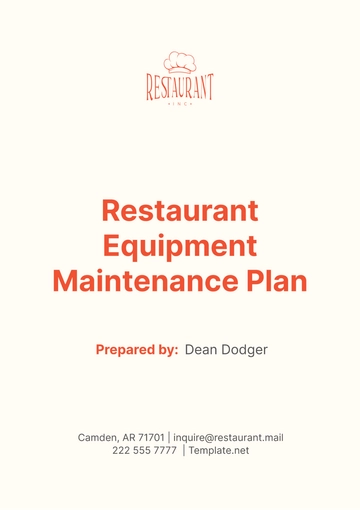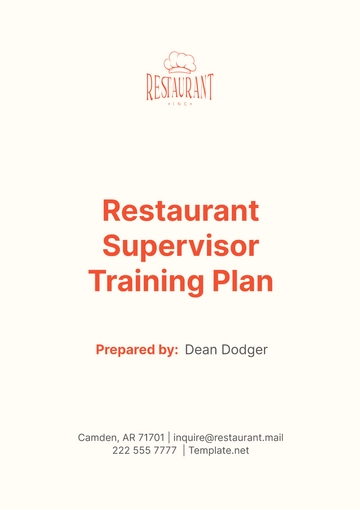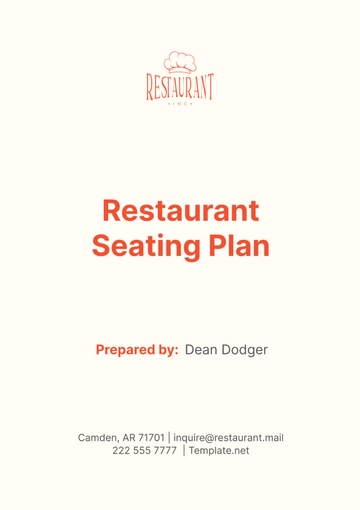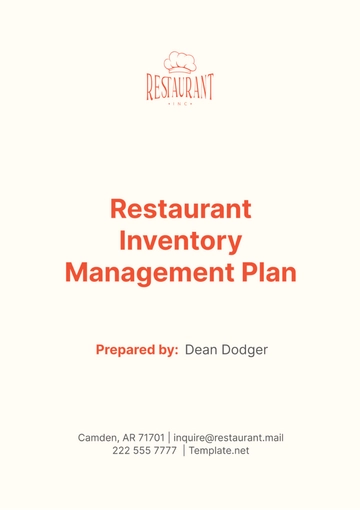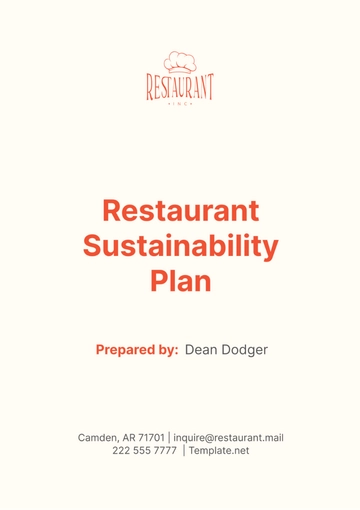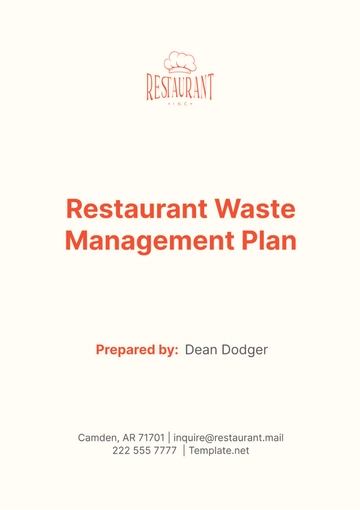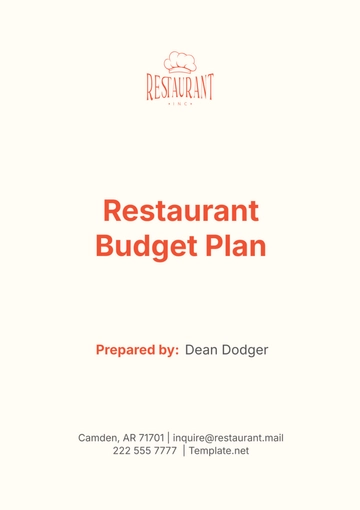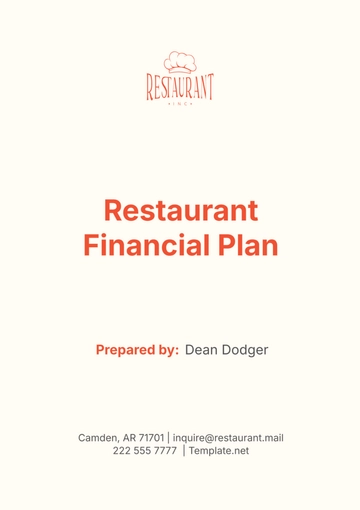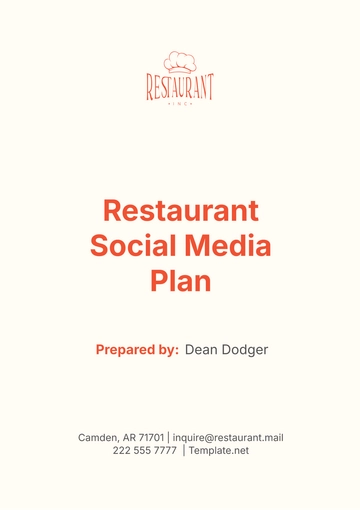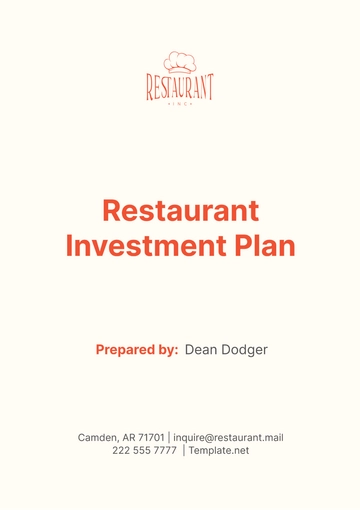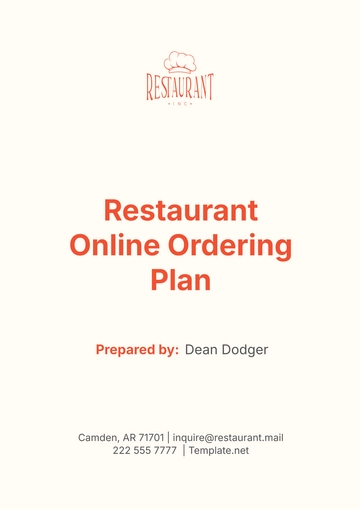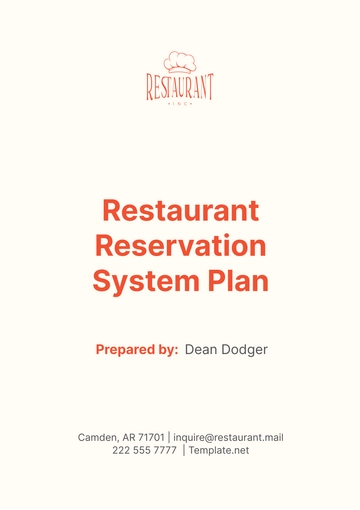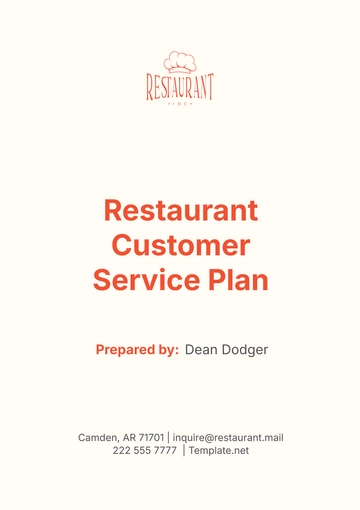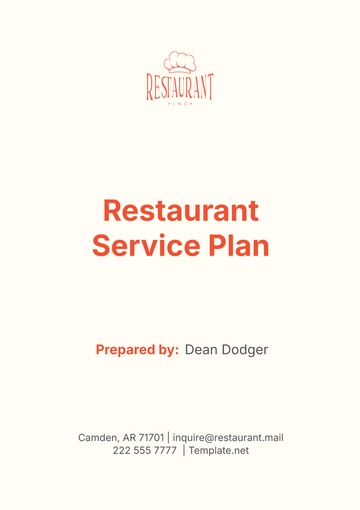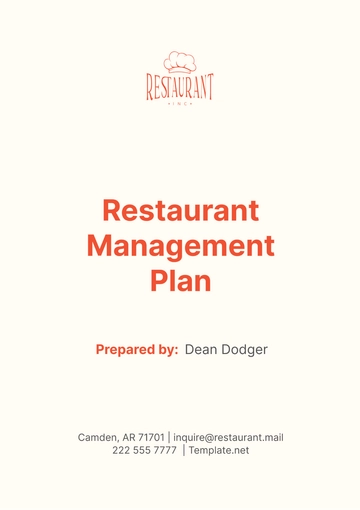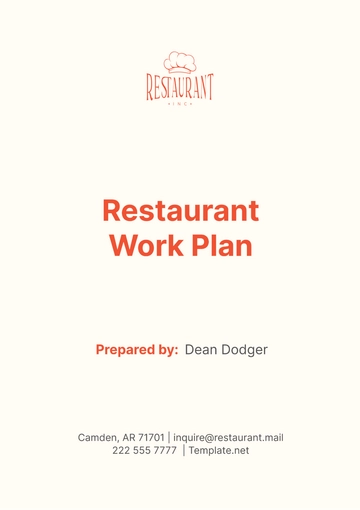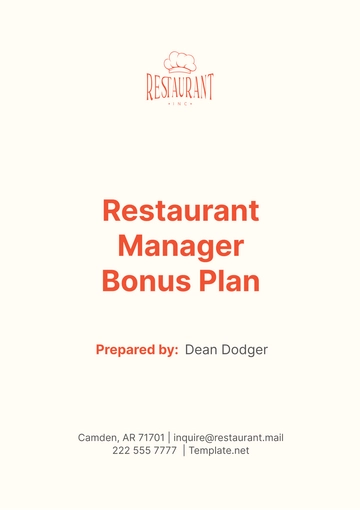Free Restaurant Waste Management Plan
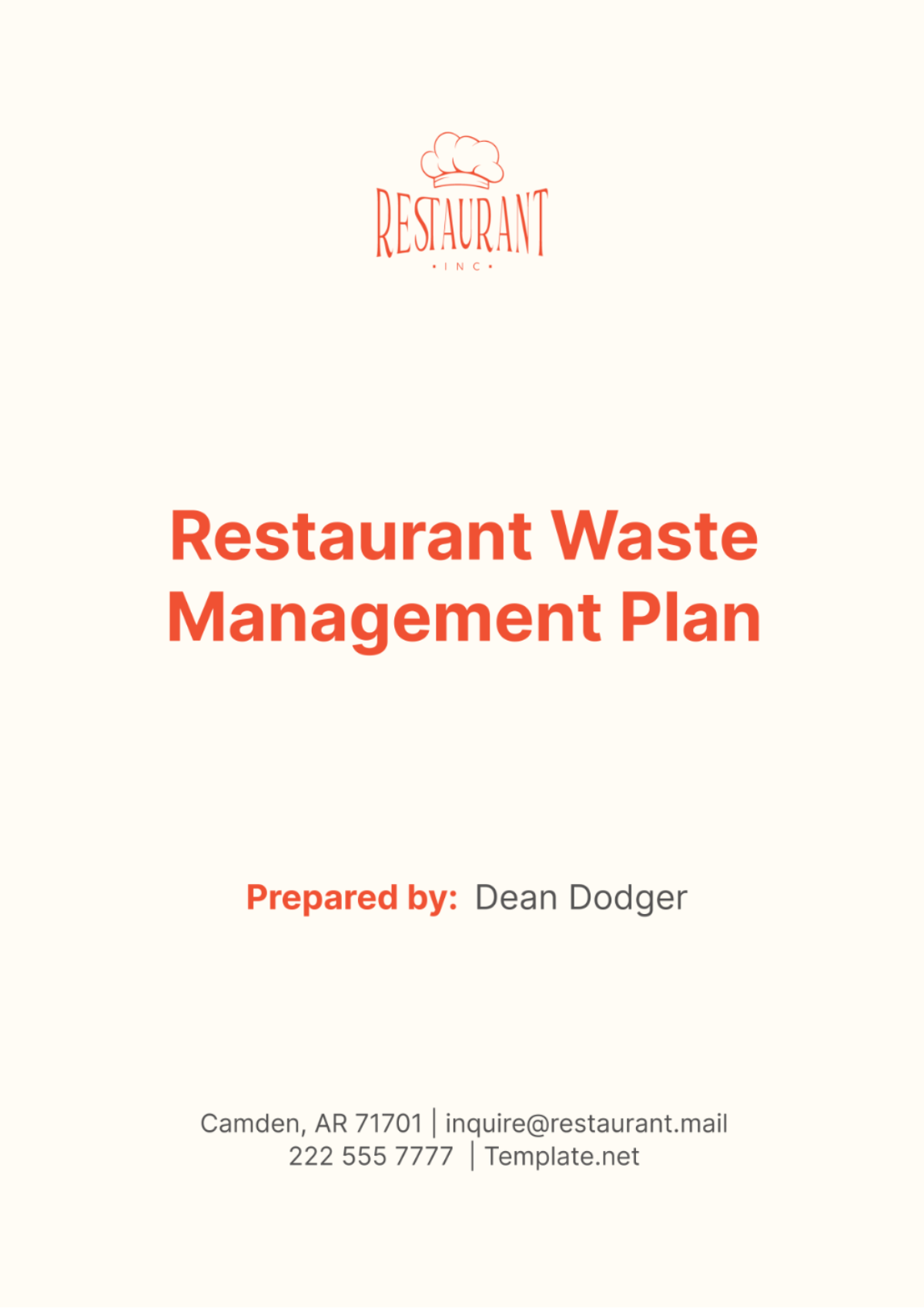
I. Introduction
A. Purpose of the Plan
The purpose of this Waste Management Plan is to create a structured approach to managing and reducing waste within our restaurant. This plan aims to minimize our environmental footprint, enhance operational efficiency, and comply with relevant regulations. Through effective waste management, we also hope to engage our staff and customers in sustainability initiatives.
B. Scope and Objectives
This plan covers all waste generated by the restaurant, including food waste, packaging, recyclables, and compostables. The objectives are to:
Reduce overall waste volume by 30% within the next year through strategic planning and execution.
Increase recycling rates to 70% of total waste by implementing comprehensive recycling programs.
Establish a composting program to handle organic waste effectively, diverting it from landfills.
C. Benefits of Effective Waste Management
Effective waste management can lead to significant cost savings by reducing disposal fees and improving resource efficiency. It also helps to enhance our restaurant's reputation as an environmentally responsible business. Additionally, it ensures compliance with local regulations, avoiding potential fines and penalties.
II. Waste Audit
A. Conducting a Waste Audit
Types of Waste: The primary types of waste include food scraps, paper products, plastics, glass, and metals. Identifying these categories helps us understand where the most waste is generated and where reduction efforts can be focused.
Sources of Waste: Waste is generated in various areas such as the kitchen, dining room, bar, and storage areas. By pinpointing specific sources, we can tailor our waste management strategies to address the most problematic areas.
Volume and Frequency of Waste: Conducting a weekly audit allows us to measure the volume and frequency of waste generated. This data is crucial for setting benchmarks and tracking progress over time.
B. Data Collection and Analysis
Methods for Data Collection: Utilize waste weighing stations and digital logs to record the weight and type of waste produced. Staff will be trained to accurately log data at the end of each shift.
Analyzing Waste Data: Analyze the collected data to identify trends, peak waste times, and areas for improvement. This analysis helps in making informed decisions about where to focus reduction efforts.
III. Waste Reduction Strategies
A. Source Reduction
Inventory Management: Implement a just-in-time inventory system to reduce excess stock that may spoil before use. Regularly review inventory levels to ensure freshness and reduce waste.
Portion Control: Standardize portion sizes to ensure consistent serving sizes, reducing both food waste and food costs. Use measuring tools and staff training to maintain portion accuracy.
Efficient Food Preparation Practices: Train kitchen staff on efficient food preparation techniques, such as proper cutting methods and utilizing the entire product, to minimize waste.
B. Menu Design
Using Seasonal and Local Ingredients: Incorporate seasonal and local ingredients into the menu to reduce transportation waste and support local farmers. This not only reduces our carbon footprint but also ensures fresher produce.
Reducing Menu Complexity: Simplify the menu to focus on a smaller number of versatile ingredients. This reduces the risk of ingredient spoilage and simplifies inventory management.
IV. Recycling Program
A. Identifying Recyclable Materials
Paper and Cardboard: Include all paper products, cardboard packaging, and office paper in the recycling program. Encourage staff to separate these items from general waste.
Plastics: Identify and sort recyclable plastics, including bottles, containers, and packaging materials. Ensure plastics are clean and free from food residue before recycling.
Glass: Collect glass bottles and jars for recycling, ensuring they are rinsed and free of contaminants.
Metals: Recycle metal cans, foil, and other metal items by providing designated bins and ensuring staff awareness.
B. Setting Up Recycling Stations
Location and Accessibility: Place recycling bins in convenient locations throughout the restaurant, such as near prep stations, in the dining area, and by the bar. Ensure bins are clearly marked and easily accessible.
Signage and Instructions: Provide clear, multilingual signage with visual aids to help staff and customers correctly sort recyclables. Regularly update instructions to reflect any changes in recycling guidelines.
C. Training Staff on Recycling Procedures
Regularly conduct training sessions to ensure all employees understand the importance of recycling and know how to properly sort materials. Provide refresher courses and updates as needed to maintain high compliance rates.
V. Composting Program
A. Identifying Compostable Materials
Food Scraps: Collect vegetable peels, coffee grounds, eggshells, and other organic waste for composting. Ensure non-compostable items are not mixed in.
Biodegradable Packaging: Use and compost biodegradable packaging materials, such as compostable to-go containers and cutlery. Clearly label these items to prevent contamination with non-compostables.
B. On-site vs. Off-site Composting
On-site: Set up designated compost bins and a composting area in the restaurant's back lot. Regularly maintain compost piles to ensure proper decomposition.
Off-site: Partner with local composting facilities for regular pickup of organic waste. This option may be more feasible for restaurants with limited space.
C. Implementation and Maintenance
Implement the composting program by providing appropriate bins and training staff on what can and cannot be composted. Regularly monitor the composting process and adjust as needed to ensure efficiency and effectiveness.
VI. Reusable and Eco-Friendly Products
A. Transition to Reusable Items
Plates and Cutlery: Replace disposable plates and cutlery with durable, washable items to reduce waste. Invest in high-quality, reusable options that can withstand frequent use.
Napkins and Tablecloths: Switch to cloth napkins and tablecloths that can be washed and reused, reducing the need for disposable paper products.
B. Eco-Friendly Packaging Solutions
Biodegradable and Compostable Options: Source to-go containers, cups, and utensils made from biodegradable or compostable materials. Ensure these items are labeled and disposed of correctly.
Supplier Partnerships: Work with suppliers who prioritize sustainability and can provide eco-friendly products. Negotiate bulk purchases to reduce costs and ensure a steady supply.
VII. Donation and Repurposing
A. Surplus Food Donation
Identifying Local Food Banks and Shelters: Partner with organizations like Food Rescue to donate surplus food. Establish a regular schedule for donations and ensure compliance with food safety standards.
Safe Handling and Storage of Donated Food: Train staff on proper procedures for storing and handling donated food to maintain safety and quality. Use labeled containers and maintain a log of donations.
B. Repurposing Leftover Food
Creative Menu Options: Develop menu items that utilize leftovers, such as soups, stews, and specials. This not only reduces waste but also adds variety to the menu.
Staff Meals: Use surplus food to prepare nutritious meals for staff, reducing waste and providing a perk for employees. Plan staff meals around leftover ingredients to ensure nothing goes to waste.
VIII. Employee Training and Engagement
A. Developing Training Programs
Orientation for New Employees: Introduce new hires to our waste management policies and procedures during their initial training. This ensures they understand our commitment to sustainability from the start and know how to participate effectively.
Regular Training Sessions: Conduct quarterly training sessions to refresh knowledge and update employees on any changes in our waste management practices. Use these sessions to address any challenges and gather feedback from staff.
B. Fostering a Culture of Sustainability
Employee Involvement and Feedback: Encourage employees to take an active role in waste management by soliciting their ideas and feedback. Create a suggestion box or hold regular meetings where staff can propose new initiatives or improvements.
Incentives and Recognition Programs: Implement reward programs to recognize employees who contribute significantly to waste reduction efforts. This could include awards, bonuses, or public recognition during staff meetings.
IX. Monitoring and Reporting
A. Tracking Waste Metrics
Methods for Monitoring Waste Output: Use a combination of digital logs and physical waste audits to track the amount and types of waste generated. Install weigh scales in key areas to facilitate accurate measurements.
Analyzing Trends and Identifying Issues: Regularly review waste data to identify trends, such as peak times for waste generation or areas where waste is not being properly managed. Use this analysis to pinpoint specific issues and develop targeted solutions.
B. Regular Reporting and Review
Internal Reporting Procedures: Generate monthly reports summarizing waste data, highlighting successes, and identifying areas for improvement. Share these reports with all staff to maintain transparency and encourage continuous engagement.
Periodic Plan Review and Updates: Annually review the waste management plan to assess progress and incorporate new practices or technologies. Adjust goals and strategies based on the latest data and industry trends to ensure the plan remains effective and relevant.
X. Compliance and Regulations
A. Understanding Local, State, and Federal Regulations
Waste Disposal Laws: Stay informed about local, state, and federal waste disposal laws to ensure our practices comply with all legal requirements. This includes understanding regulations around food waste, recycling, and hazardous materials.
Recycling and Composting Regulations: Familiarize ourselves with specific recycling and composting guidelines provided by local authorities. Ensure that our recycling and composting programs meet these standards to avoid fines and penalties.
B. Ensuring Compliance
Regular Audits and Inspections: Conduct internal audits and inspections regularly to verify compliance with waste management regulations. Address any issues promptly and make necessary adjustments to our procedures.
Documentation and Record Keeping: Maintain detailed records of all waste management activities, including waste audits, training sessions, and regulatory compliance reports. This documentation helps in tracking progress and serves as proof of compliance during inspections.
XI. Customer Engagement
A. Educating Customers on Waste Reduction Efforts
Informational Signage: Place informational signs in visible areas, such as near recycling bins and on menus, to inform customers about our waste reduction efforts. Highlight how they can contribute, such as by using reusable containers or properly sorting their waste.
Marketing and Communication Strategies: Use social media, newsletters, and the restaurant’s website to communicate our sustainability initiatives to customers. Share success stories and tips for reducing waste at home to further engage our audience.
B. Encouraging Customer Participation
Incentives for Using Reusable Containers: Offer discounts or loyalty points to customers who bring their own reusable containers for takeout. This not only reduces waste but also builds customer loyalty.
Feedback and Suggestions: Provide easy ways for customers to give feedback on our waste management practices, such as comment cards or online surveys. Use this feedback to improve our efforts and demonstrate that we value their input.
XII. Conclusion
A. Summary of Key Points
This Waste Management Plan outlines our commitment to reducing waste through targeted strategies, employee engagement, and customer participation. By focusing on waste reduction, recycling, composting, and sustainable practices, we aim to create a more environmentally friendly restaurant operation.
B. Commitment to Continuous Improvement
We are dedicated to continuously improving our waste management practices. Regular reviews and updates to this plan will ensure that we adapt to new challenges and opportunities, maintaining our commitment to sustainability.
C. Contact Information for Questions and Feedback
For more information or to provide feedback on our Waste Management Plan, please contact the General Manager at [Your Company Email] or [Your Company Number]. Your input is valuable in helping us achieve our sustainability goals.
- 100% Customizable, free editor
- Access 1 Million+ Templates, photo’s & graphics
- Download or share as a template
- Click and replace photos, graphics, text, backgrounds
- Resize, crop, AI write & more
- Access advanced editor
Introducing the Restaurant Waste Management Plan Template from Template.net! This fully editable and customizable template simplifies sustainability planning for your restaurant. Use the AI Editor Tool to tailor it to your specific needs effortlessly. Save time, reduce waste, and enhance your eco-friendly practices with this comprehensive, easy-to-use template. Get started today!
You may also like
- Finance Plan
- Construction Plan
- Sales Plan
- Development Plan
- Career Plan
- Budget Plan
- HR Plan
- Education Plan
- Transition Plan
- Work Plan
- Training Plan
- Communication Plan
- Operation Plan
- Health And Safety Plan
- Strategy Plan
- Professional Development Plan
- Advertising Plan
- Risk Management Plan
- Restaurant Plan
- School Plan
- Nursing Home Patient Care Plan
- Nursing Care Plan
- Plan Event
- Startup Plan
- Social Media Plan
- Staffing Plan
- Annual Plan
- Content Plan
- Payment Plan
- Implementation Plan
- Hotel Plan
- Workout Plan
- Accounting Plan
- Campaign Plan
- Essay Plan
- 30 60 90 Day Plan
- Research Plan
- Recruitment Plan
- 90 Day Plan
- Quarterly Plan
- Emergency Plan
- 5 Year Plan
- Gym Plan
- Personal Plan
- IT and Software Plan
- Treatment Plan
- Real Estate Plan
- Law Firm Plan
- Healthcare Plan
- Improvement Plan
- Media Plan
- 5 Year Business Plan
- Learning Plan
- Marketing Campaign Plan
- Travel Agency Plan
- Cleaning Services Plan
- Interior Design Plan
- Performance Plan
- PR Plan
- Birth Plan
- Life Plan
- SEO Plan
- Disaster Recovery Plan
- Continuity Plan
- Launch Plan
- Legal Plan
- Behavior Plan
- Performance Improvement Plan
- Salon Plan
- Security Plan
- Security Management Plan
- Employee Development Plan
- Quality Plan
- Service Improvement Plan
- Growth Plan
- Incident Response Plan
- Basketball Plan
- Emergency Action Plan
- Product Launch Plan
- Spa Plan
- Employee Training Plan
- Data Analysis Plan
- Employee Action Plan
- Territory Plan
- Audit Plan
- Classroom Plan
- Activity Plan
- Parenting Plan
- Care Plan
- Project Execution Plan
- Exercise Plan
- Internship Plan
- Software Development Plan
- Continuous Improvement Plan
- Leave Plan
- 90 Day Sales Plan
- Advertising Agency Plan
- Employee Transition Plan
- Smart Action Plan
- Workplace Safety Plan
- Behavior Change Plan
- Contingency Plan
- Continuity of Operations Plan
- Health Plan
- Quality Control Plan
- Self Plan
- Sports Development Plan
- Change Management Plan
- Ecommerce Plan
- Personal Financial Plan
- Process Improvement Plan
- 30-60-90 Day Sales Plan
- Crisis Management Plan
- Engagement Plan
- Execution Plan
- Pandemic Plan
- Quality Assurance Plan
- Service Continuity Plan
- Agile Project Plan
- Fundraising Plan
- Job Transition Plan
- Asset Maintenance Plan
- Maintenance Plan
- Software Test Plan
- Staff Training and Development Plan
- 3 Year Plan
- Brand Activation Plan
- Release Plan
- Resource Plan
- Risk Mitigation Plan
- Teacher Plan
- 30 60 90 Day Plan for New Manager
- Food Safety Plan
- Food Truck Plan
- Hiring Plan
- Quality Management Plan
- Wellness Plan
- Behavior Intervention Plan
- Bonus Plan
- Investment Plan
- Maternity Leave Plan
- Pandemic Response Plan
- Succession Planning
- Coaching Plan
- Configuration Management Plan
- Remote Work Plan
- Self Care Plan
- Teaching Plan
- 100-Day Plan
- HACCP Plan
- Student Plan
- Sustainability Plan
- 30 60 90 Day Plan for Interview
- Access Plan
- Site Specific Safety Plan
